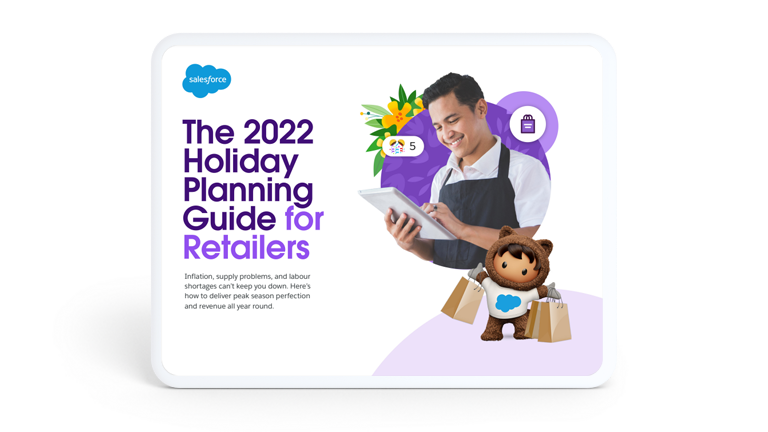Rising consumer pessimism means retailers need to work harder this holiday season to keep shoppers merry. How do you balance the online and in-store retail shopping experience? How do you contend with a more complicated path to purchase? How do you keep customers satisfied and spending at the same time?
The answer is to create a seamless retail shopping experience that knits digital and physical touchpoints together. For companies, that starts with creating agility across online and mobile commerce channels. But it also means giving customers greater flexibility when browsing and buying, no matter how they choose to shop.
Here’s what you can do to get your online and brick-and-mortar channels ready for the 2022 holiday shopping season.
Digital experiences are transforming retail
Inside this guide, learn how to: Use data to capture wallet share, simplify multichannel shopping journeys, digitise brick-and-mortar experiences and more!

Tip #1: Offer faster mobile commerce experiences
Put yourself in the shoes of a time-starved holiday shopper who’s suddenly remembered a must-order gift. Would you rather hop in the car, pull out your laptop, or grab your phone?
With mobile commerce getting more popular every year and margins tightening by the minute, it’s never been more important to optimise your mobile commerce experience. In fact, in the second quarter of 2022, mobile accounted for 71% of traffic share and 61% of total order share. Make phone and tablet shopping easier with:
- Mobile-specific marketing: Does your mobile app send push notifications when an out-of-stock product returns to inventory in time for holiday delivery? Do you send well-timed text messages to your best customers when a flash sale starts? If not, it’s time to add that to your holiday retail strategy.
- Hassle-free browsing and checkout: Opt for simple designs that load fast and add bigger “buy now” buttons that are easy to find on a mobile device. Consider enabling one-step purchases right from the product page, and don’t forget to add convenience-focused payment options. Mobile wallets, for example, ensure customers won’t have to scramble at the point of purchase to find their credit card.
- A fantastic post-purchase experience: Consider that 41% of digital leaders are prioritising experiences like returns optimisation over the next two years. Ensure your self-service channels are optimised for mobile so customers can perform routine tasks from their phones.
Tip #2: Make social selling part of the retail shopping experience
How can you help your customers find the right products when so much depends on flat Instagram images on a small screen? By enabling associates (or even influencers) to interact with your customers on a live stream, you can turn virtual retail shopping experiences into personalised and physical interactions.
Suddenly, your customers can see the product from different angles, ask about flexible fulfilment options like same-day delivery or in-store pickup, and inquire about return policies. That process helps customers avoid buying gifts that won’t work and has the potential to reduce online return rates, which can be as high as 20.8%.
Leading retailers are already perfecting the art of capturing customers’ attention on platforms like Facebook, Instagram, and TikTok. That’s not just for vanity’s sake: All signs indicate that social commerce is just getting started. In fact, it’s predicted to grow three times faster than traditional e-commerce over the next four years.
“Consumers live on their phones, and pushing your brand experience and checkout to these social networks helps remove the friction that a consumer encounters between discovery and purchase,” Rob Garf, Salesforce’s vice president and general manager, retail, told Retail TouchPoints earlier this year.
Tip #3: Prioritise fulfilment and inventory optimisation
Nothing says “bah, humbug” quite like finding out the product you ordered online is out of stock or stuck somewhere on a slow supply chain. As retailers face continued inventory and shipment challenges, digital leaders are solving the problem by prioritising fulfilment and inventory optimisation. What does that mean in simple terms? Now’s the time to solve the “where is my order” problem once and for all:
- Prioritise transparency: Does an offer for a comparable product mean your customers won’t mind if a shipment is delayed or unavailable? No. But at least you can be honest and transparent — something that 74% of customers say is important. And by keeping open a line of communication, you can be the holiday hero who shows up with potential solutions.
- Empower your customers: Ensure your customers can access their order history, track delivery, and use self-service to arrange a return or exchange. Enable flexible fulfilment options, like buy-online-pick-up-in-store (BOPIS), a choice that’s popular with customers and that’s been adopted by 85% of retailers.
- Rethink order management: The right order management system gives your online and in-store associates access to real-time inventory and fulfilment data. When your employees can follow customer orders from the point of purchase through delivery, they can stay proactive if there’s a problem — like offering a similar product that’s available for on-time shipment.
Only 24% of retailers and brands have “out of stock” notifications for sold-out items online, according to the 2022 Omnichannel Retail Index. “This feature could be a differentiator especially as we continue to experience supply chain and logistical challenges,” said Kathy Kimple, executive director at OSF Digital, a commerce and digital cloud transformation company. “This could be useful in multiple ways: communication and keeping the customer in the know, re-capturing the sale when it’s back in stock, and messaging them about alternative options.”
Tip #4: Add flexible payment options
As inflation lingers, flexible payment options are bound to grow in popularity. With some consumers saying they may not buy any gifts this year, programs like buy-now-pay-later (BNPL) may make an important difference in the retail shopping experience and to retailers’ profitability. Digital leaders are twice as likely as digital laggards to prioritise investments in flexible payments: One company grew average order value by 50% after implementing BNPL.
Delaying payments or offering instalment options aren’t the only ways retailers are rethinking transaction flexibility. Apple Pay, for example, is increasing in popularity: While 54% already accept Apple Pay, another 34% plan to add the option within two years. Not only do mobile wallet options streamline transactions with one-click payments, they also expand the number of payment options customers have at checkout.
Give holiday shoppers the gift of convenience this year by removing friction from their retail shopping experience.
The 2022 Holiday Planning Guide for Retailers
Tighter margins mean retailers need to innovate to stay competitive during the 2022 holiday shopping season. Here, we share what you can do now to optimise your holiday retail strategy.

























